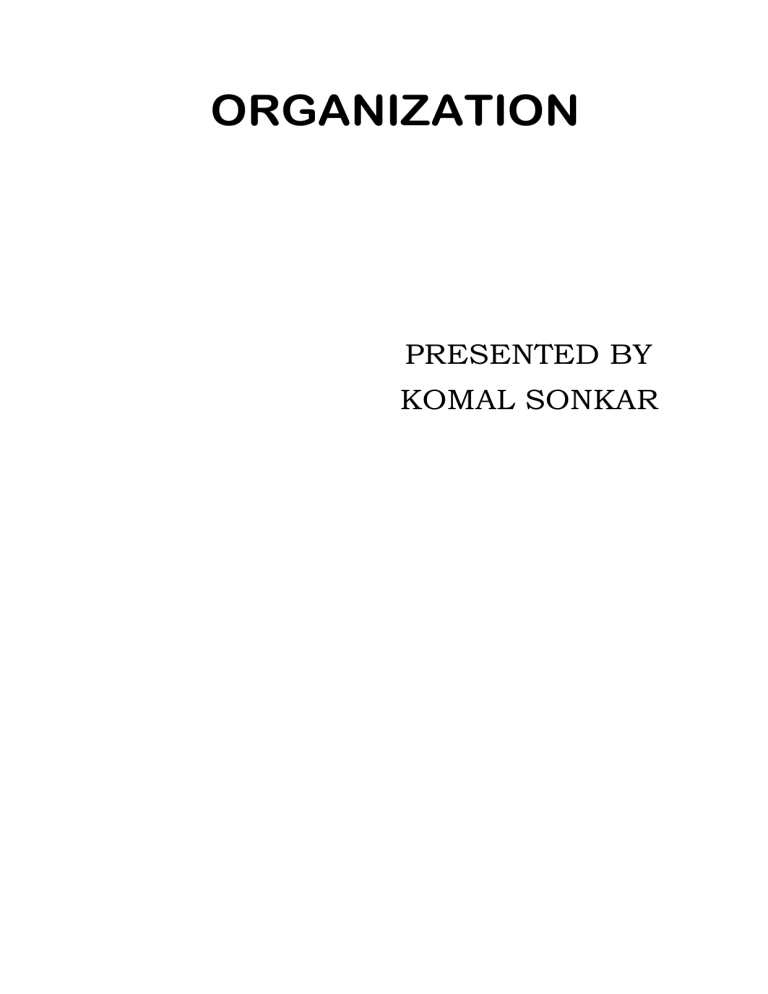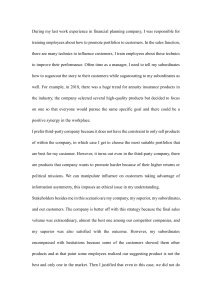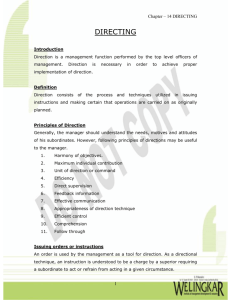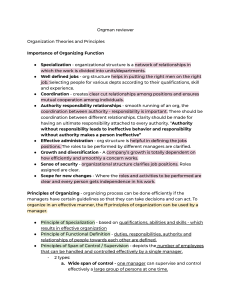Organization in Business Management: Principles & Importance
advertisement

ORGANIZATION PRESENTED BY KOMAL SONKAR WHAT DO YOU MEAN BY ORGANISING Organizing is the process of a series of steps by which managers create a network of authority and responsibility relationship .The purpose of organizing is to enable people to relate to one another and to work together for a common objective. IMPORTANCE OF ORGANISATION IN BUSINESS MANAGEMENT Specialisation In the process of organising, work is divided and subdivided into compact and convenient jobs. Optimum Use a Human Resources The role, tasks, authority and responsibility of every job are clearly defined and differentiated. This helps fitting the right person to the right job, enables better use of a human talent and provides job satisfaction to employees. Coordination and Cooperation A clear-cut definition of authority and responsibility of each manager minimises confusion and conflict about the respective powers and privileges of manager. Security and Support A sound organisation Structure is a source of security, support and satisfaction to managers and workers performing their assigned tasks. Training and Development of Personnel Sound organisation encourages top initiative and creative thinking on the part of employees. THE STEPS IN THE PROCESS OF ORGANISING 1. Division of Work The first step in organising is to divide the total work to be done into specific jobs. 2. Grouping Jobs and Activities Once jobs and activities are defined, the next step is to classify or group them into manageable units and place each group of activities under the charge of a manager. 3. Assigning Duties To establish the reporting relationship for all individual employees of the company .So the manager establishes the vertical and horizontal relationships of the company. 4. Delegation of Authority After assignment of duties, appropriate authority is delegated to each individual .Without such authority a person cannot carry out the assigned job. 5. Coordinating Activities The activities and effort of different individuals are then properly synchronised. SPAN OF MANAGEMENT Span of management means the number of subordinates who can be managed efficiently by a superior .The managers have the group of subordinates who report to him directly. ADVANTAGE OF A LINE ORGANISATION 1. Simple to work 2. It is the stable form of organization. 3. The overall cost of running the organization is low due to the non-involvement of staff personnel. 4. Economical and effective. It also allows quick decisions and efficient coordination. 5. The responsibility for the performance of task is fixed upon definite individuals. DISADVANTAGE OF A LINE ORGANIZATION 1. Instability 2. Lack of cooperation 3. Inefficiency 4. Improper communication 5. Excess work FACTORS DETERMING SPAN OF MANAGEMENT 1. Capacity a Superior : Here the Capacity means the ability of a superior to comprehend the problems quickly and gel up with the staff such that he gets respect from all. 2. Capacity of Subordinate : If the Subordinate Is trained and efficient in discharging his functions without much help from the superior, the organization can have a wide span. 3. Nature of Work : If the Subordinates are required to do a routine job, with which they are well versed ,then the manager can have a wider span. 4. Degree of Decentralization's ; If the manager delegates authority to the subordinates then he is required to give less attention to them . 5. Staff Assistance : The use staff assistance can help the manager in reducing his work lead by performing certain managerial tasks. DEFINITION OF LINE AUTHORITY Line authority is the power given to someone in a supervisory position to mandate actions by subordinates. It is the type of authority that reflects superior - subordinate relationships.








